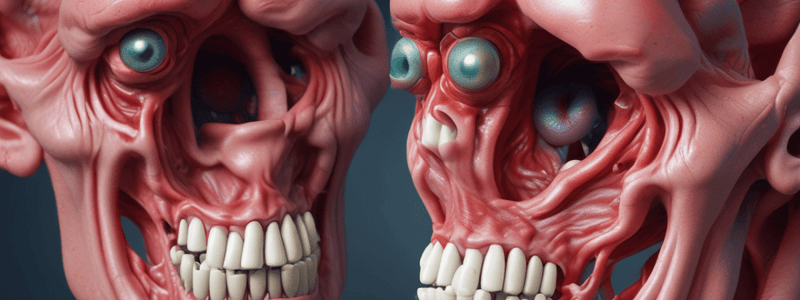Podcast
Questions and Answers
Which muscle is responsible for closing the eyelids?
Which muscle is responsible for closing the eyelids?
- Orbicularis Oculi (OO) (correct)
- Risorius
- Zygomaticus Major
- Corrugator Supercilii
What does the measurement of the temporal resolution of eyeblink startle responses (EBRs) reveal?
What does the measurement of the temporal resolution of eyeblink startle responses (EBRs) reveal?
- The magnitude and duration of emotional responding
- The level of arousal evoked by emotional stimuli
- The ability to regulate emotional responses
- All of the above (correct)
What does the magnitude of emotional responding indicate?
What does the magnitude of emotional responding indicate?
- The level of arousal evoked by emotional stimuli
- The intensity of the emotional reaction
- How complete the emotional recovery is (correct)
- The speed of emotional recovery
What is the purpose of the International Affective Picture System (IAPS)?
What is the purpose of the International Affective Picture System (IAPS)?
Which of the following is NOT a characteristic used to match positive and negative pictures in the IAPS?
Which of the following is NOT a characteristic used to match positive and negative pictures in the IAPS?
What does the time course of emotional responding indicate?
What does the time course of emotional responding indicate?
What is the eyeblink startle reflex (EBR) used to measure?
What is the eyeblink startle reflex (EBR) used to measure?
Which of the following is NOT a component of the TRA-LA-LA-LA mnemonic for Cognitive Behavior Therapy and Resilient Thinking?
Which of the following is NOT a component of the TRA-LA-LA-LA mnemonic for Cognitive Behavior Therapy and Resilient Thinking?
What is the purpose of the International Affective Picture System (IAPS) in the context of the study described?
What is the purpose of the International Affective Picture System (IAPS) in the context of the study described?
Which muscle is responsible for the eyeblink startle reflex (EBR)?
Which muscle is responsible for the eyeblink startle reflex (EBR)?
What is the proposed relationship between purpose-in-life and emotional recovery, according to the study?
What is the proposed relationship between purpose-in-life and emotional recovery, according to the study?
Which of the following techniques is NOT part of the TRA-LA-LA-LA mnemonic for Cognitive Behavior Therapy and Resilient Thinking?
Which of the following techniques is NOT part of the TRA-LA-LA-LA mnemonic for Cognitive Behavior Therapy and Resilient Thinking?
Which of the following is NOT a characteristic of the emotional recovery process observed in individuals with higher levels of purpose-in-life?
Which of the following is NOT a characteristic of the emotional recovery process observed in individuals with higher levels of purpose-in-life?
According to the passage, the central role of the amygdala in fear potentiation of startle responses is hypothesized in which type of emotional responses?
According to the passage, the central role of the amygdala in fear potentiation of startle responses is hypothesized in which type of emotional responses?
Which of the following is a key characteristic of the International Affective Picture System (IAPS) used in the studies described?
Which of the following is a key characteristic of the International Affective Picture System (IAPS) used in the studies described?
What is the primary mechanism proposed to explain the relationship between higher purpose-in-life and better emotional recovery from negative stimuli?
What is the primary mechanism proposed to explain the relationship between higher purpose-in-life and better emotional recovery from negative stimuli?
Which of the following would be the most appropriate measure of the temporal resolution of emotional responses in the studies described?
Which of the following would be the most appropriate measure of the temporal resolution of emotional responses in the studies described?
Study Notes
Delayed Emotional Recovery in Depression and Dysphoria
- Delayed emotional recovery is observed in depression and dysphoria
- Subjects who report higher levels of purpose-in-life demonstrate greater emotional recovery from negative pictures
Adaptive Regulation and Emotional Recovery
- Adaptive regulation is associated with quicker and more complete emotional recovery
- Greater emotional recovery is associated with higher purpose in life
The Role of Amygdala in Emotional Regulation
- The amygdala plays a central role in fear potentiation and emotion-modulated startles
- Poor recovery from negative stimuli is observed in depressed individuals who display sustained pupil dilation and amygdala activation to negative words
Mechanisms of Emotional Recovery
- Greater purpose in life motivates one to constructively learn from and reappraise negative events adaptively
- Orbicularis oculi (OO) muscle is a 'eyelid' muscle that reflects affective states and emotional responses to stimuli
Eyeblink Startle Responses (EBRs)
- EBRs serve to differentiate emotional responses and their regulation
- Magnitude of EBRs reflects the completeness of emotional recovery
- Time course of EBRs reflects the quickness of emotional recovery
International Affective Picture System (IAPS)
- IAPS is a systematic photo collection that evokes positive, negative, and neutral emotional reactions
- 30 negative, 30 neutral, and 30 positive pictures are used, matched on arousal evocation, luminosity, complexity, and social content
Cognitive Behaviour Therapy and Resilient Thinking
- TRA-LA-LA-LA is a mnemonic device for cognitive behaviour therapy and resilient thinking
- The components of TRA-LA-LA-LA are:
- Thought substitution
- Reframing
- Attentional investment
- Lowering anxiety
- Leveraging attention
- Learning alliance
Studying That Suits You
Use AI to generate personalized quizzes and flashcards to suit your learning preferences.
Related Documents
Description
Test your knowledge on the orbicularis oculi muscle, its function in closing the eyelids, and the temporal resolution of eyeblink startle responses in reflecting emotional states and responses to stimuli.




